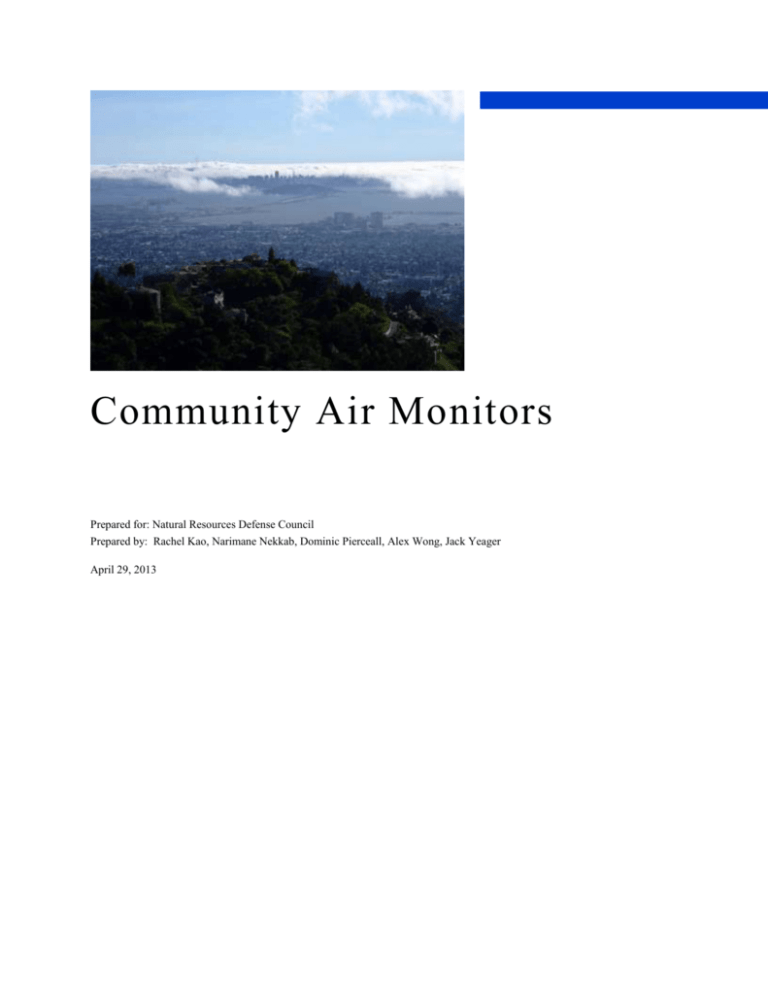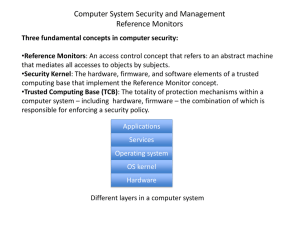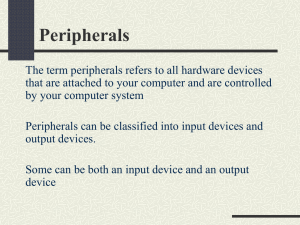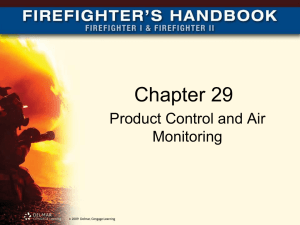here - Switchboard, from NRDC
advertisement

Community Air Monitors Prepared for: Natural Resources Defense Council Prepared by: Rachel Kao, Narimane Nekkab, Dominic Pierceall, Alex Wong, Jack Yeager April 29, 2013 TABLE OF CONTENTS Background 1 Quick-look Table 1 Detailed Descriptions 1 Air Metrics: MiniVol Portable Air 1 Berkeley Air Monitoring Group: UCB-PATS 1 Dylos Corporation: DC1100 & DC1700 1 Industrial Scientific: Gasbage Pro 1 Sigma-Aldrich: Radiello Diffusive Sampler 1 Sensemaker: Air Quality Egg 1 TSI: Model 3007 1 Recommendations 1 Community Air Monitors 1 Background The goal of the Natural Resources Defense Council’s Community Air Monitoring Project is to introduce low cost air monitors to potentially vulnerable communities that are lacking air quality data. The Bay Area Air Quality Management District has not placed air monitoring sites in areas thought to have the highest pollutant levels; therefore there is limited data on air quality in many of these vulnerable communities in the Bay Area. Advocates have fought for increased air monitoring and now there is a federal law under the recently updated National Ambient Air Quality Standards (NAAQS) and Near Roadway provision (mandated by the Environmental Protection Agency (EPA)) that requires expansion of air monitoring. However, many people are still exposed to hazardous air in near roadway areas and delays in siting these monitors make it imperative to begin to characterize near roadway environments through community-led self-monitoring. The EPA recently hosted a “Next Generation Air Monitoring Workshop Series.” Much of the work presented was focused on the development of low-cost and easy-to-use air monitors. One plan being developed is researching cost-effective, portable and compact electrical ultrafine particle sizers with a wireless eUFP sensor network. Work is also being done by a UCSD group, funded by the U.S. EPA, to research a compact, low-cost, network accessible, optical particle counter. After laboratory characterization of these devices, the monitors will be deployed for further investigation and testing. In conclusion, the EPA is now considering developing more compact and affordable air monitors. The goal of this report is to assess and recommend air monitors that are reliable, affordable and can be easily handled by community residents. Air monitors are assessed by the following: cost, accuracy (relative consistency), ease of use, pollutants measured (preferably particulate matter as well as combustion pollutants like CO, NO X, SO2), availability, power and infrastructure requirements, data collection methods, and storage. The particular context in which these monitors can be used is also addressed. The goal of compiling information on the various citizen air monitors will allow people to collect data on their personal air pollutant exposure levels experienced by living next to hazardous facilities and busy roadways to illustrate the problem of elevated exposure. From an advocacy perspective, a Community Air Monitoring Project would help define the quality of their environment, drawing attention to highly polluted areas and supporting the urgent need for official government monitoring stations in locations with the highest pollutant levels. Community Air Monitors 2 Monitors Quick-look Table Company Model Size Airmetrics MiniVol Portable Air Sampler Suitcase Berkeley Air Monitoring Group UCB-PATS Dylos Corporation DC1100 Dylos Corporation DC1700 Industrial Scientific Gasbadge Pro Pine Environmental BGI PQ100 Sigma-Aldrich Diffusive Sampler Sensemakers Air Quality Egg TSI Model 3007 Community Air Monitors Pollutant PM 2.5-10, Heavy Metals, CO2, NOx Handheld PM 2.5 Handheld PM .05 - 2.5 Handheld PM .05 - 2.5 Handheld either: H2S, NO2, SO2 Handheld PM 10 Handheld Cost VOC’s, NO2, SO2, Aldehydes, Ozone, Hydrogen Sulfide, Ammonia, and HCL Handheld NO2, SO2 Shoebox PM 1-10 $3,400 $550 $290 $425 $275 $500-$1200 (depending on pollutants measured) $185 $10,000 3 Detailed Descriptions Air Metrics: MiniVol Portable Air Airmetrics is a company which focuses on developing and manufacturing air monitoring devices. Their customers include the US EPA, USDA ARS, and the World Health Organization to name a few. Airmetrics and the US EPA worked together in order to develop the low-flow technology in the MiniVol Portable Air Sampler. The MiniVol Portable Air Sampler is assessed for proper Quality Assurance and Quality Control. The results that the monitor gives out matches similarly to the Federal Reference Method samplers. It is important to note however, that it matches approximately and is not up to the approved list of Federal Reference Methods samplers that the EPA developed. The fully configured monitor can function at 10lbs, but the total weight with all of the monitor’s accessories including the pump module, battery packs, battery charger, mounting bracket, impactors, impactor adapters, filter holder assemblies and transportation case is up to 40 lbs. The dimensions of the monitor is 10” by 12” by 7”; however, the transportation case which holds all the accessories and monitor is 19.75” by 12” by 18”. Although it claims that it is a portable monitor, the monitor is still fairly bulky and heavy. The monitor runs on rechargeable lithium ion batteries and can be fully charged in less than 6 hours. The monitor measures PM10, PM2.5, heavy metals, Polycyclic Aromatic Hydrocarbons and diesel. The only downside is that it can only be configured to collect one type of air pollutant at a time. One exception is that gas samples can be taken along with the particulate matter samples. The monitor will pump in and filter 5 liters of air per minute. Different types of filters are placed within the monitor in order to measure the different air pollutants in the air. These filters will filter out a specific pollutant and will then be extracted and weighed. Air Metrics offers filter weighing services complementary to the MiniVol. This monitor was used to monitor the air quality in West Berkeley, a neighborhood that is downwind from Pacific Steel Casting, a large steel foundry. Pacific Steel Casting is known to have emitted large amounts of pollutants.1 The results have allowed the Bay Area Air Quality Management Board and Pacific Steel to come to develop an agreement in order to reduce the odors and emissions from Pacific Steel. 1 "West Berkeley Community Monitoring Project." Berkeley Citizen. N.p., 2012. Web. 1 Mar. 2013. <http://www.berkeleycitizen.org/Air%20Quality/monitor.htm>. Community Air Monitors 4 Berkeley Air Monitoring Group: UCBPATS The purpose of the Berkeley Air Monitoring Group is to develop, design, research indoor air pollution monitors and methodologies. The Berkeley Air Monitoring Group has ties with and works with the School of Public Health at the University of California, Berkeley. Their research is geared towards indoor air pollution in developing countries such as China, Nepal, Cambodia to name a few. One of their products is the University of California, Berkeley Particle and Temperature Sensor (UCB-PATS). UCB-PATS is a lightweight (0.48lbs) indoor air pollution monitor. The shape and size (11.7 cm in diameter and 6.2 cm in height) of the monitor is that of a smoke detector so it is easy to hold in one hand. The monitor can be placed on any flat surface, making the placement of the monitor easy. The monitor contains a photoelectric detector which can measure PM2.5 from 25 μg/m3 to 25,000 μg/m3. While it measures PM concentrations, UCB-PATS also records the temperature and battery voltage. The UCB-PATS requires one 9 volt battery which will operate for 5 days and have a storage capacity of 32,768 records. Dr. Kirk Smith’s Research Group at UC Berkeley developed the software program, UCB Particle Monitor Device Manager, in which the UCB-PATS can store the collected information. The Berkeley Air Monitoring Group has a free step by step manual setup of the UCB Particle Monitor Device manager on their website. The data is stored on the monitor device and can record at 1 - 240 minute intervals. After the data collection, a USB cable can be used to transfer the data from the monitor to a computer. The UCB Particle Monitor Device Manager will be able to download the data and display the data in graphical form. This is a fairly easy way of collecting data and customizing the data collection intervals. The only problem you may face when collecting data is syncing the computer clock time with that of the air monitor. The clocks should be set at the same time in order to correlate the time with the air pollutant measurements recorded. To properly store the monitor, the monitor should be stored in a ziploc bag and should be stored in an environment that is 40 to 100°F. The ziplock bag will allow for the monitor to adjust itself to measure zero particulate matter. In terms of accuracy, these devices have been used since 2003 and have been used in field trials in Guatemala, Mexico, India and other locations. The monitor can measure down to 25 μg/m3. This device can be purchased for $550 or rented for $50 per month. The Berkeley Air Monitoring Group will be developing a newer version of the UCB-PATS, but they do not know when the new model will be ready for commercial use. Community Air Monitors 5 Dylos Corporation: DC1100 & DC1700 DC1100 The DC1100 is an indoor home or office monitor and is the only monitor in this report that must be plugged in to a A/C outlet. It has a laser particle counter that counts individual particles that ranges from small to large particles. The monitor uses a “focused laser which results in a drastically higher signal to noise ratio” meaning that the laser is sensitive enough to detect individual particles. The large particle count is for pollens, dust mite debris, insect feces, and coarse dust. The small particle counter covers most bacteria, mold, and fine dust. The monitors immediately respond to changing environment and store the data up to 30 days within the device. These monitors are very easy to use. After they are plugged in and turned on, the DC1000 will configure itself automatically. The DC1100 Pro Air Quality Monitor with PC Interface is $289.99. It can detect particles down to 0.5 microns in size. The large particle size is calibrated to 2.5 microns and above. The LCD screen shows small and large particle counts with a bar graph that shows the actual count readings. There are multiple modes that can be used to evaluate the air quality such as minute, hour and day. The data for all of the monitors is stored up to 30 days and can be sent to a PC for graphing and analysis. DC1700 The DC1700 Battery Operated Air Quality Monitor is priced at $425.00. This monitor is also a true laser particle counter with a measurement range of 0.5 to greater than 2.5 microns. It is a battery-operated monitor that provides up to 6 hours of continuous use on a single charge. The monitor can also be plugged in using the included wall adapter. The monitor has an improved PC Interface feature. The data stored includes the time it was taken and the data output and can be readily transferred to a program such as Excel. The DC1700 monitor also has the largest internal memory of all the monitors assessed and it is able to store about 10,000 samples – a week’s worth of time-stamped data recorded at every minute. Along with a real-time clock, the DC1700 also has an EMI shielding feature to protect against electro-magnetic interference that can be found in the environment. Like the DC1100 Pro EMI, the DC1700 also has the rapid update feature. Community Air Monitors 6 Industrial Scientific: Gasbage Pro The Industrial Scientific Gasbadge Pro is a single gas sensor that measures nitrogen dioxide. The air monitor can also be fitted to monitor carbon monoxide, hydrogen sulfide, nitrogen dioxide, sulfur dioxide, chlorine, chlorine dioxide, phosphine, ammonia, hydrogen and hydrogen cyanide. The unit is water resistant, shock resistant and only has four buttons so it should be easy to use. It comes with one year of data logging. It runs on a replaceable CR2 lithium battery for a minimum of 2,600 hours of continuous operation measures of nitrogen dioxide from 0-150 ppm by 0.1 ppm increments. The main limitations of this device is that it can only measure one gas at a time and it does not measure particulate matter; however, it is convenient in that other sensors can be fitted to the device. Measuring nitrogen dioxide could be a good gas to start with because burning fossil fuels is one of the main ways the gas is created so putting sensors next to roadways should reveal important and valuable data. Another concern is that the Industrial Scientific Gasbadge Pro monitors are only “water resistant” so they may need to be reinforced with extra protection and/or installed under some sort of overhang. Community Air Monitors 7 Sigma-Aldrich: Radiello Diffusive Sampler Passive Diffusive Sampling monitors are made by Sigma-Aldrich, an international life science and high technology company. The Radiello diffusive samplers are a type of air monitor that involve using chemicals to absorb the toxins in the air rather than actively passing the air through the testing device. Their advantage is that the testing unit does not require electric power. The disadvantage is that diffusive samplers have been used effectively to monitor workplace environments since the 1930’s but questions have been raised as to whether or not they are sensitive enough for environmental monitoring. However Sigma-Aldrich claims that its testers are sensitive enough to be used anywhere; additionally they claim their testers do not produce inaccurate samples when left for a short or long period, as is common with other diffusive testers(2). Another disadvantage is that they cannot test for particulate matter; however, they do test for BTEX, VOC’s, HF, NO2, SO2, Aldehydes, Ozone, Hydrogen Sulfide, Ammonia, and HCL(3). The kit comes with forty cartridges that you can load with testers to monitor the various chemicals mentioned above. In its entirety, the product cost around $1200 dollars, depending on how many different chemicals you wish to test. It is also possible to purchase just a few of these chemical testerss at a time. The monitors test 2 to 4 chemicals each and the price range is from $200 to $500. The passive diffusive samplers could be a good cheap option to supplement a powered PM monitor in order to test other gasses and vapors. The fact that these types of monitors have been used to monitor workplaces in the past adds to their credibility. The only worry is that there are no additional outside sources that confirm that the company has fixed the problems that the older monitors had with precise exposure times and low sensitivity. Community Air Monitors 8 Sensemaker: Air Quality Egg The Air Quality Egg is made by Sensemakers based in New York. The initial project was fundraised on Kickstarter and was fully funded in 4 days on April 26th, 2012. Various upgrades have been made of the initial Egg prototypes due to the project’s community-driven collaborative nature. The standard sensor platform is available for purchase on WickedDevice for $95. The standard sensor detects nitrogen dioxide (NO2) and carbon monoxide (CO) in which they claim gives “very high resolution readings of NO2 and CO concentrations.”[1] These sensors are temperature and humidity dependent. Sensor upgrades to monitor dust and particulate matter (of unknown size) can be purchased for $40, ozone for $25, gamma and beta radiation for $60, and VOCs and hydrocarbon sensors for $25. The upgrades are engineered into a modular plug-and-play system.[1] The Air Quality Egg monitor is now being sold by WickedDevice for $185.[3] The monitor consists of two systems: the outdoor sensor and the Egg base station. The outdoor sensor is a small electronic sensing system that plugs into the wall and remains outside to take regular readings. It contains the sensors and the RF transmitter, which sends the data wirelessly to the Egg-shaped base station inside. The Egg base station receives the wirelessly transmitted data from the sensor box outside and then relays the data to the Internet via a wired Ethernet connection. [4] It is not known if a user interface has been developed. In terms of data collection, air quality data will be sent in real-time to Pachube – an open data service that stores and provides free access to the data online. The data is displayed on a web-based dashboard accessible from anywhere. The service includes embeddable graphs of the data streamed and has the ability to generate triggers for tweets and SMS alerts.[1] There is also a website dedicated to mapping the locations of all of the deployed sensors around the world. [5,6] The ease of use of the monitor is unknown. Images and videos of the sensor make it seem very lightweight. Various forums report many issues arising with setup and sensor results by user.[7,8] Due to this, the product is still in its initial testing phase and many users with background in the technical aspects of the monitor are in the process of adjusting it and testing it on their own terms. The WickedDevices forum also demonstrates many of the issues associated with the setup of the sensor and most especially the data. The power source for both the outdoor sensor and the indoor base station is a plug-in power cord to outlet. The durability of the outer casing enclosure is unknown; however, the WickedDevices forum has user testimonials that give a unanimous consensus on the enclosure’s waterproof quality.[7] The reliability of the quality of the data from the Air Quality Egg is unknown and is a heavily debated topic online. Sensemaker states that: “The sensors will not be calibrated and their precision and sensitivity is mediocre [...] the Air Quality Egg project was not defined as a way to gather precise, scientific air quality data. It was defined as a way to give people a way to participate in the conversation!”[9] Therefore, the accuracy of the sensors is unknown and developers are reluctant to study the monitor's calibrations, although there are websites dedicated to providing resources to those who want to analyze the data.[10] Independent analysis of the data has been done by David Holstius of the University of California, Berkeley; however, his analyses are only extrapolations and do not have Community Air Monitors 9 the support of nearby data. He concluded that there may be high sensor to sensor variability between each deployed egg. Work is being done to calibrate the Egg by various individuals, but there is no consensus on the accuracy of all the Eggs. It should be noted that in the near future, one randomly selected Egg sensor is going to be chamber tested with other sensors by the EPA soon and that this data may be shared with the public soon as well. The event represents the beginning of air monitoring sensor evaluation collaboration between outside developers and EPA scientists.[11] Community Air Monitors 10 TSI: Model 3007 The Model 3007 is a portable condensation particle counter (CPC) manufactured by TSI Incorporated. The monitor supersaturates a sample with isopropanol alcohol forming condensates around ultrafine particles. The growing condensates can be detected by a laser within the monitor. This model uses isopropanol as the working fluid while most other CPCs use butanol (Mordas et al. 2013). This is an advantage because isobutanol is one of the least toxic butanols. The monitor can detect particles between 10 nanometers and 1 micrometers in diameter; however, it cannot differentiate between them. It also tends to underestimate concentrations because particles may strike the sides of the sensing chamber before the laser can detect them (Wallace et al. 2011). Although the manufacturer, TSI claims that Model 3007 is rated to particles up to 1 micrometer, multiple studies have shown that it almost exclusively measures UFP or PM1 (Wu et al. 2008, Wallace 2002, Wallace 2011). The manufacturer also claims that the concentration is accurate to +/- 20%. This statement has been verified in a study by the University of Helsinki in 2002. (Hämeri et al. 2002). In terms of data storage, measurements are made in less than 10 seconds and the monitor can save up to 50,000 points in its onboard storage with the option of exporting the data to a computer. Currently this monitor seems to be used primarily in indoor and outdoor air pollution studies. The Model 3007 is powered by 6 AA batteries which last for 5-10 hours. The isopropanol also is consumed in a similar time. They are simple to use and provide quick accurate results, weighing just 4 pounds. This monitor is at the high end of the cost range at $10,000. Community Air Monitors 11 Recommendations In terms of cost, accuracy and portability we highly recommend the Dylos Corporation’s air monitoring products. The Dylos Corporation offers a variety of monitors with various prices, accuracy, and storage capacities. All of the air monitors measure 2 size ranges, small (PM2.5) and large (PM10). On the lower end of the price range, the DC1100 Air Monitor is the most affordable at $200; however, it lacks the PC interface option that would make analysis of the data easier to do. The DC1700 is the most accurate monitor with a higher storage capacity and a longer battery life. Although it is $225 more expensive than the DC1100 Air Monitor, it would fulfill many of the requirements for the Community Air Monitoring Project. Because of the size and weight, at 1.2 lbs, the Dylos Corporation’s products are extremely portable and relatively inexpensive. Individuals of the community would be able to use these air monitors. One thing that is important to point out is that these monitors were designed to work indoors and to use a plugin power supply. After the Dylos Corporation’s air monitoring products, we would rank Airmetrics’ MiniVol Portable Air Sampler second. We were mostly concerned with the size and price of the air monitor. Once fully configured the air monitor is roughly 10 lbs. This is approximately 8 times heavier than that of the Dylos Corporation air monitors. The monitor costs $3,450 and filters PM2.5 and gas on filter samples. Other filters are available to collect heavy metal, polycyclic hydrocarbon, and diesel samples. Although the price is fairly steep, the price includes free analysis of the samples by US EPA approved laboratories. Also, it may not be necessary for each individual to have a monitor, but to have a community buy several and place them throughout their neighborhood. For example, the community of West Berkeley bought several of these monitors in order to collect data on the toxic emissions coming from the Pacific Steel Casting foundry. As a result, the foundry had to pay a fine and regulate their emissions. Because of its success already as a community oriented device this air monitor would be a good choice for the Community Air Monitoring project. The Berkeley Air Monitoring Group from UC Berkeley developed the Berkeley Particle and Temperature Sensor, UCB-PATS. This monitor would be good for the Citizen Air Monitoring project because it is accurate and portable. The UCB-PATS measures PM2.5 from 25 μg/m3 to 25,000 μg/m3; it also measures temperature as well. In terms of portability, the UCB-PATS is as small as a smoke detector and weighs 0.48 lbs. It is one of the lighter air monitors in comparison with all the others. The downside is it costs $50 per month to rent and $550 to buy. The other downside is that it is designed for an indoor environment just like the Dylos Corporation’s air monitoring products. The Berkeley Air Monitoring Group however, is currently developing a newer version of this model. They are not sure when it will be available for commercial use. In comparison to other monitors, the Air Quality Egg would not be highly recommended for the Natural Resources Defense Council’s Community Air Monitoring project. While the idea behind the development of the Egg coincides very well with the aims of the Community Air Monitoring project, in terms of focusing on acquiring data where government data fails and to bring this data to light in order to create a dialogue between the community members the EPA; the quality of the data is a major drawback. More consistent or accurate data is required to serve as solid evidence of air pollution exposure disparities. The Model 3007 by TSI Incorporated would have been a great air monitor that communities could use because of its accuracy. It can measure a PM range of 0 to 100,000 particles per cubic centimeter. The collected data is then analyzed through a computer program, Aerosol Instrument Manager and can be exported into a user friendly excel file. The only downside to this monitor is that it is very expensive. The cost of the Model 3007 is $10,000. Thus, this would not be a good choice for community members to use. Community Air Monitors 12








